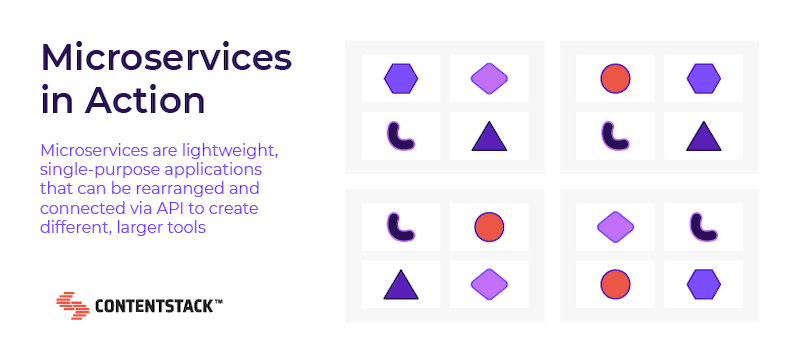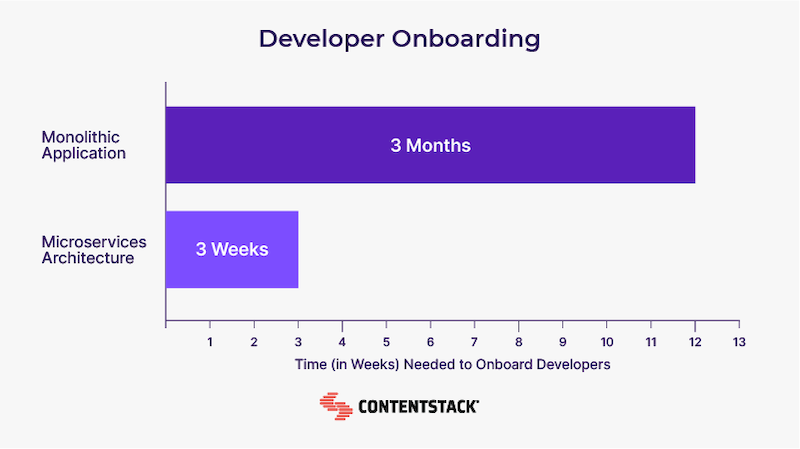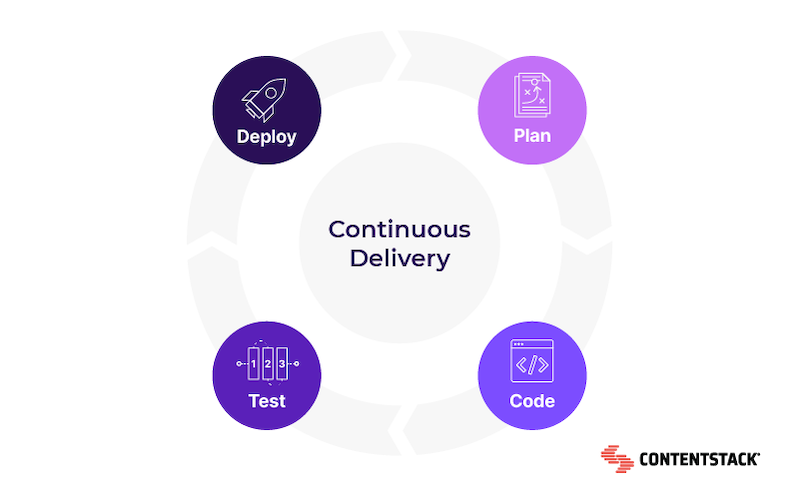7 microservices benefits you shouldn’t ignore

Implementing microservices at your organization is no easy task.
While microservices will soon be the norm for managing content, right now you may still have to explain and socialize the concept to your organization in order to gain buy-in.
For marketers, developers, and management teams at enterprise-level organizations, microservices architecture provides a cleaner, faster, and more efficient approach to dealing with a growing user base and expanding feature set.
In this resource, we’ll break down several key benefits that you can share with your tech decision-makers to show why your organization should take advantage of microservices and get ahead of your competitors.
Quick refresher: what are microservices?
A “microservice” is a small, single-purpose application.
Microservices function in cooperation with other components within applications, but they are independently deployed and managed.
For example, if your application features the ability to pay online and the ability to handle shipping, those functions would be delivered as separate microservices. Microservices are a key element of what’s known as MACH technology.
MACH technology is microservices-based, API-first, cloud-native, and headless. MACH is becoming the gold standard among future-ready enterprises because of how easy it makes swapping out services to maximize scalability and meet changing business needs.

While microservices-based technology may sound more complicated than the legacy, monolithic applications many organizations are used to, there is a long list of both business and technological benefits associated with microservices.
Key microservices benefits
Although microservices architecture allows each organization to customize their technology to best fit their needs, there are also many broadly applicable advantages that most organizations can benefit from.
1. Enhance business functionality
Let’s start with the obvious — embracing a microservices architecture allows you to deliver a superior product.
By decoupling the components of your technology, you can more easily make changes to a particular component, knowing that it won’t interrupt another part of the overall system. This way, you can look at your backlog of feature requests from a business perspective, as opposed to a technology perspective.
The ability to adapt individual services for different contexts without having to re-code the entire module from the ground up is extremely valuable to the end product.
Your technology shouldn’t prevent you from making changes that increase user engagement, revenue, or satisfaction. Rather, the technology should enable the change. With microservices, it can.
Additionally, dividing up different services makes sense from a business and planning perspective. For instance, if your software has features for both payment and shipping, your developers and product managers should be able to make improvements to one without disrupting the other.
2. Enjoy effortless productivity
“Business Utopia” can be described as a place where marketers and IT are in lockstep, adding new business users and churning out new features in the pursuit of that coveted hockey stick growth curve.
Unfortunately, this is rarely the case in enterprise organizations.
The marketing department’s proposed product response to customer needs can affect how the technology is implemented; if it’s implemented at all. Adding more developers to cope with demand often creates a 90-day period of limbo while they get up to speed on all the idiosyncrasies of your codebase.
With microservices architecture, these productivity issues can be mitigated by allowing for polyglot programming.
No need to have HR spend months looking for the candidate who can code in the language you’re using or spend time training them — thanks to modularity, a microservices approach allows developers to use the language best suited for the job at hand.
This speeds up the developer onboarding process significantly, allowing them to get to work quicker.

And because each service can be worked on individually without the risk of interruption to other services (or a lengthy integration project), your organization can utilize smaller, more agile development teams working on specific areas of the application.
3. Reduce risk through fault tolerance and isolation
One of the lesser-known benefits of having your services separated is that if one of them breaks, it’s unlikely to take the whole system offline — which is often the case in monolithic applications.
Each microservice comes fully equipped with everything it needs to do its job. That means when an error does occur, it’s much more likely that you’ll experience reduced functionality in a specific capacity rather than across the whole operation.
Additionally, this type of decoupling allows you to easily identify which module the issue resides in and keep it isolated to an environment where it can be examined and fixed, therefore reducing your time to resolution.
4. Employ continuous delivery and integration

A staple of DevOps philosophy, continuous delivery carries a huge benefit for enterprise organizations or large, complex applications.
Microservices enable continuous delivery because each component can be written, tested, and deployed on an independent schedule — offering tons of freedom for developers and product managers.
There is compelling evidence that continuous delivery and integration can have widespread benefits.
In fact, the HP LaserJet Firmware division found that implementing a philosophy of continuous delivery had the following business benefits:
- Reduced overall development costs by 40%
- Increased programs under development by ~140%
- Decreased costs per program by 78%
Microservices mean fewer product and feature releases being delayed because of one team waiting on the other to push their updates.
5. Stay flexible and scalable
The ability to scale is crucial for enterprise organizations and large applications.
Monolithic applications, however, are making it harder and harder to scale due to tightly intertwined functionality that’s practically impossible to update or change without breaking.
But with a microservices architecture, businesses can scale individual components (as opposed to the entire application) as the need arises. This allows you to focus resources where you need them the most, rather than simply playing catch-up to ensure you don’t take the system offline.
The ability to scale services independently of one another adds flexibility to your application, marketing department, and development teams — a triple win that can help future-proof your products.
6. Keep maintenance quick and easy
As we mentioned in both benefit #2 (productivity) and #5 (scalability), modules built with microservices generally have smaller codebases. This means that it’s much easier for development teams to keep the code clean and compact.
Additionally, because these modules are managed by a single team without dependencies on other components or teams, there is an extra level of accountability. From a project management perspective, bug fixes and product changes will be a lot simpler, thus increasing the ease of maintenance.
7. Deploy at lightning speed
There’s nothing quite like walking into the weekly status meeting and having the pleasure of telling your management team that your release is actually ahead of schedule. Unfortunately that’s practically unheard of for teams struggling under the weight of bloated legacy systems.
In addition to the independent nature of each moduler (which allows teams to work and push updates asynchronously), teams using microservices can increase the speed of their deployments through a more streamlined quality assurance process. Because the codebase is smaller, tighter, and more focused, the testing and QA are far simpler and require fewer hours to complete.
Ready to reap these microservices benefits?
We think this list of the top microservices benefits is more than enough to convince your key tech decision-makers that it’s time to make the switch to microservices architecture.
If your organization is looking to join the ranks of Amazon, eBay, Netflix, and many other of the largest applications in the world, adopting the new tools and modern philosophies they’re already using is the place to start.
For more information on the philosophy, practice, and details of microservices architecture, check out Microservices: The Ultimate Guide
About Contentstack
The Contentstack team comprises highly skilled professionals specializing in product marketing, customer acquisition and retention, and digital marketing strategy. With extensive experience holding senior positions at renowned technology companies across Fortune 500, mid-size, and start-up sectors, our team offers impactful solutions based on diverse backgrounds and extensive industry knowledge.
Contentstack is on a mission to deliver the world’s best digital experiences through a fusion of cutting-edge content management, customer data, personalization, and AI technology. Iconic brands, such as AirFrance KLM, ASICS, Burberry, Mattel, Mitsubishi, and Walmart, depend on the platform to rise above the noise in today's crowded digital markets and gain their competitive edge.
In January 2025, Contentstack proudly secured its first-ever position as a Visionary in the 2025 Gartner® Magic Quadrant™ for Digital Experience Platforms (DXP). Further solidifying its prominent standing, Contentstack was recognized as a Leader in the Forrester Research, Inc. March 2025 report, “The Forrester Wave™: Content Management Systems (CMS), Q1 2025.” Contentstack was the only pure headless provider named as a Leader in the report, which evaluated 13 top CMS providers on 19 criteria for current offering and strategy.
Follow Contentstack on LinkedIn.




.svg?format=pjpg&auto=webp)
.svg?format=pjpg&auto=webp)
.png?format=pjpg&auto=webp)






.png?format=pjpg&auto=webp)

